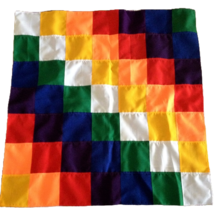Rendered at 05:34:39 06/10/25
Free Shipping
Wiphala Indigenous flag - Collectible Flag Native Andean People Symbol (50cm2)
Ships from
Chile

Shipping options
Offer policy
OBO - Seller accepts offers on this item.
Details
Return policy
None: All purchases final
Purchase protection
Payment options
PayPal accepted
PayPal Credit accepted
Venmo accepted
PayPal, MasterCard, Visa, Discover, and American Express accepted
Maestro accepted
Amazon Pay accepted
Nuvei accepted
Shipping options
Offer policy
OBO - Seller accepts offers on this item.
Details
Return policy
None: All purchases final
Purchase protection
Payment options
PayPal accepted
PayPal Credit accepted
Venmo accepted
PayPal, MasterCard, Visa, Discover, and American Express accepted
Maestro accepted
Amazon Pay accepted
Nuvei accepted
Item traits
| Category: | |
|---|---|
| Quantity Available: |
Only one in stock, order soon |
| Condition: |
New |
| Country/Region of Manufacture: |
Chile |
| Country of Manufacture: |
Chile |
Listing details
| Seller policies: | |
|---|---|
| Shipping discount: |
Seller pays shipping for this item. |
| Price discount: |
10% off w/ $120.00 spent |
| Posted for sale: |
More than a week ago |
| Item number: |
1721109167 |
Item description
The Wiphala is an ancient flag that has represented various indigenous peoples of the Andes in Peru, Bolivia, Ecuador and northern Chile and Argentina throughout the centuries. It is now the co-official flag of Bolivia, and although it has been associated with the Inca Empire, and more recently the Aymaras, it is thought to date back the the Tiwanaku civilisation which emerged from the shores of Lake Titicaca in modern-day Bolivia and was the predecessor of both the Inca Empire and Aymara kingdoms.
It has been present in agricultural works, formal festivities, and ceremonies and later as a symbol of resistance against invaders for more than 1000 years. In addition, it is still raised today on all social occasions, civic ceremonies and community works.
There is much debate on what exactly the colours and their orders represent and sadly, we may never know for sure. However, here are some
theories.
This design originates from dispersion of solar light, i.e. how the white rays of the sun refract into the seven
different colors which we perceive to be the rainbow.
The white diagonal series represents the coming together of the different or opposite but complementary and harmonic sides, or the meeting of two spaces; Urinsaya (the upper space) and aransaya (the lower space). From this duality comes unity, like the chacha-warmi (literally husband-wife, i.e. marriage).
The various diagonal series of seven contrasting colors represent the meeting of the different peoples in the same territory, akin to the harmony of
the seven musical notes.
The union of seven equally-proportioned colors of the Wiphala is a symbol of unity and equality, representing harmony among the different peoples and the Wiphala is an expression of the Andean philosophy and cosmovision.
Our Wiphalas are finely embroidered by traditional craftsman and are 50cm by 50cm in length and width, and our buyers include representatives of the Aymara community in Santiago, who buy them for use during their rituals, indigenous rights campaigns and cultural events.
Added to your wish list!

- Wiphala Indigenous flag - Collectible Flag Native Andean People Symbol (50cm2)
- 1 in stock
- Price negotiable
- Handling time 3 days.
Get an item reminder
We'll email you a link to your item now and follow up with a single reminder (if you'd like one). That's it! No spam, no hassle.
Already have an account?
Log in and add this item to your wish list.






















